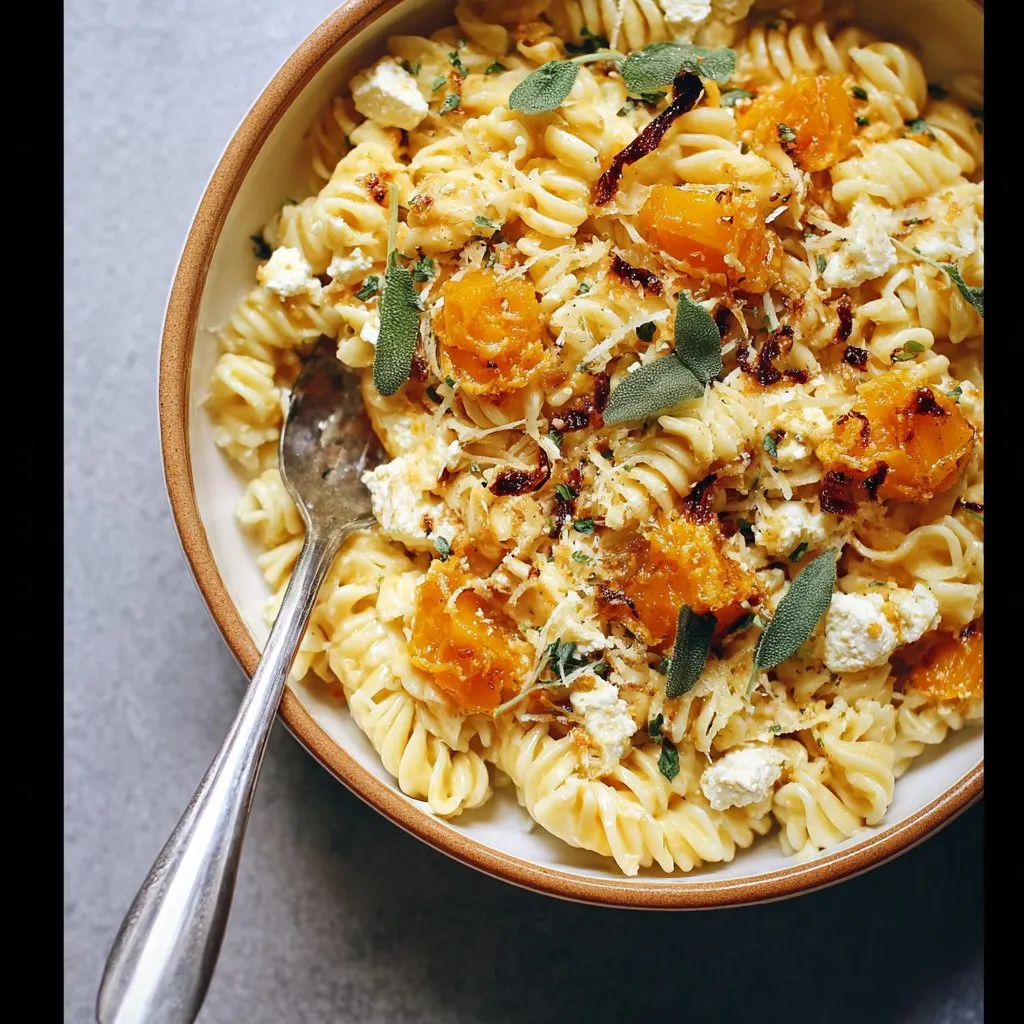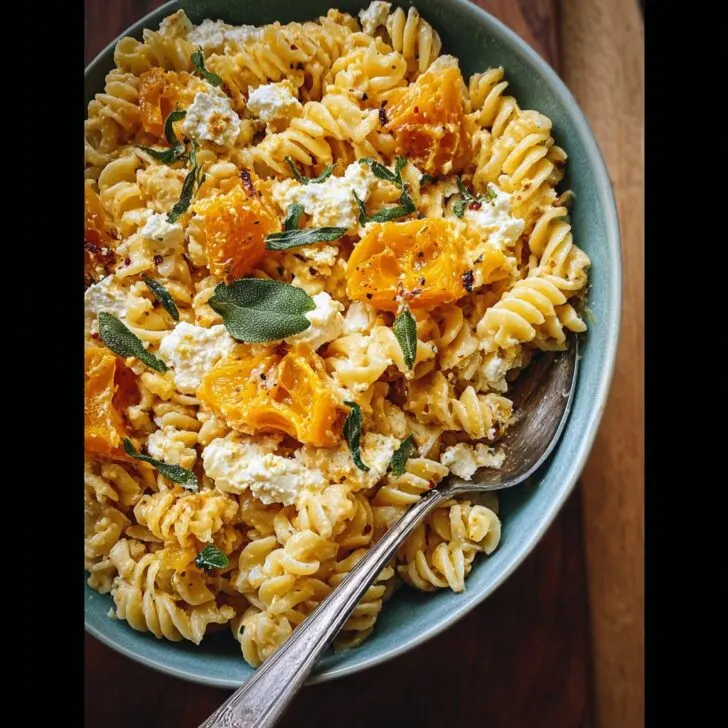Picture this. It is Tuesday, the kind where the day just keeps throwing socks at you, and you want dinner that feels like a warm jumper. I made this Baked Feta and Butternut Squash Pasta with Sage and Garlic after a long walk when the air smelled like leaves and someone nearby was clearly baking something delightful. I came home, tossed squash and garlic on a tray, nudged a block of feta into the middle, and honestly, by the time the sage got crispy I was grinning like I had just found a fiver in an old coat pocket. There is some magic here. Not flashy, just comfortable and very hello new favorite.
Why I reach for this on busy nights
I make this when I want dinner that is both cozy and a little bit fancy without really trying. My family goes a bit wild for the crispy sage bits and the way the feta turns all creamy and tangy at once. The squash gets sweet and caramelized, which, by the way, won me over after I finally learned to cut it small enough so it roasts quickly. I used to rush it and ended up with squash that was steamed rather than roasted, and that was a meh moment. But, learned and moved on. Also, if I am being honest, I like sneaking a hot cube of squash off the tray while the pasta cooks. It is the cook's tax.
What you need in the kitchen today
- 1 medium butternut squash, about 800 g peeled and diced into small cubes, roughly 1.5 cm
- 200 g feta, a block if you can find it. My grandmother always insisted on a particular brand, but honestly any version works fine
- 5 to 6 garlic cloves, peeled. If they are huge, slice them in half
- A handful of fresh sage leaves, around 10 to 12, plus extra for serving if you are feeling fancy
- 3 tablespoon olive oil, more if your tray looks dry
- 1 teaspoon kosher salt, plus more to taste
- Black pepper, a good few grinds
- Pinch of chili flakes, optional, but I like the tiny kick
- 400 g short pasta, like rigatoni or penne or shells. I sometimes use farfalle when I am in a hurry
- Zest of 1 lemon, plus a squeeze of juice if you like brightness
- 1 tablespoon butter, optional, for gloss and a bit of richness
- Toasted walnuts or pine nuts, a small handful, optional but delightful
- Extra virgin olive oil, a drizzle for finishing
Substitutions I actually use: goat cheese instead of feta when that is what is in the fridge, sweet potato instead of squash if the shop was out, and dried sage in a pinch, though reduce it a smidge. Gluten free pasta works nicely too, just keep an eye on cook time. If you only have pre cut squash, that is grand, I do that on hectic weeks and it is totally fine.
Step by step, mostly
- Heat the oven to 220 C or 425 F. Pop a large baking tray in the oven while it heats. Preheating the tray helps the squash caramelize instead of sulk.
- In a bowl, toss the squash with olive oil, salt, pepper, and chili flakes. Carefully pull the hot tray out, tip the squash onto it, and make a little space in the middle. Snuggle the block of feta there. Scatter the garlic cloves around. No perfection required.
- Roast for 20 minutes. At this point, add the sage leaves to the tray, drizzle them with a whisper of oil, and return to the oven for 5 to 8 minutes more. The squash edges should be bronzed, the garlic softened, the feta a bit golden on top. Do not worry if it looks a bit weird at this stage, it always does.
- Meanwhile, boil the pasta in well salted water until just shy of al dente. Reserve a big mug of pasta water. This is where I usually sneak a taste of a pasta shell, purely for quality control, obviously.
- Transfer the roasted garlic to a big bowl and mash it with a fork. Now add the feta and mash again until creamy. It will look a bit lumpy and that is fine. Tip in the roasted squash and sage. Splash in a good bit of hot pasta water and stir until it loosens into a sauce. Add the butter if using and the lemon zest. Taste. Adjust salt and pepper.
- Fold in the hot pasta, tossing and stirring so every piece gets a coat. If it feels too thick, add more pasta water. If it feels too loose, give it a minute to sit, the pasta drinks it up.
- Finish with a squeeze of lemon juice if you like zing, a drizzle of extra virgin olive oil, plus toasted nuts on top for crunch. Serve straight away while the sage is still crisp.
On second thought, if you want it even creamier, hold back a little pasta water and add it right at the table, it somehow brings it back to life like a wee kitchen spell.
Notes I scribbled in the margin
- Cut the squash small. This changed the game for me. Big chunks take ages and go soft without caramelizing.
- If your garlic looks like it is browning too fast, tuck it under a squash piece. I used to wrap it in foil, but actually, I find it works better if it is tucked and lightly basted with oil.
- Use block feta if possible. Pre crumbled can go slightly chalky when baked. That said, I have used crumbles in a pinch and it was still lovely.
- Preheating the tray really does speed things up. I forgot once and wondered why the squash looked shy about color. Learned.
Variations I tried so you dont have to
- Spinach toss. I folded in a handful of baby spinach at the end and let the heat wilt it. Looked pretty, tasted fresh.
- Sausage crumble. Cooked some fennel sausage and added it with the pasta. Not vegetarian anymore, but very weekend worthy.
- Pumpkin swap. Did the exact same method with pumpkin. Needed a couple extra minutes, but it worked a treat.
- Tomato cameo. I tossed in a handful of cherry tomatoes for the last 10 minutes. Juicy pops, nice with the lemon.
- What did not work. I once crumbled the feta all over the tray instead of leaving it in a block. It dried out on me and went a bit squeaky. I regretted that because the sauce never quite came together.
Gear I use, plus a cheeky workaround
A large baking tray feels essential here so everything can spread out; crowding equals steaming. A microplane for the lemon zest is lovely, but if you do not have one, a small knife to peel off thin strips then chop finely is fine. I stir in a big mixing bowl because it gives me room to toss without flinging pasta across the room. If you are short a tray, two smaller trays work, or even a heavy oven safe skillet. Sorted.

Storing leftovers, reheating, and reality
Keep leftovers in a sealed container in the fridge up to 3 days. Reheat gently on the stove with a splash of water, or a bit of milk if you want soft and creamy. I think this tastes better the next day, the flavors mingle in that cozy way. Though honestly, in my house it never lasts more than a day.
How I like to serve it
A peppery salad on the side is spot on. Rocket leaves with olive oil and a pinch of salt. Sometimes I add a soft boiled egg on top of the pasta for a cheap little luxury. If we are feeling celebratory, a glass of crisp white and a little bowl of chili oil on the table makes everyone happy. My cousin dunks garlic bread in the sauce, and I cannot argue with that.
Pro tips I learned the spicy way
- I once tried rushing the roast and cranked the heat higher. The sage burned, the garlic sulked, and the feta split. Patience pays.
- Do not skip the pasta water. I did, and the sauce felt tight and grainy. The starchy water binds it into its dreamy self.
- Season the squash generously. The feta brings salt, yes, but the squash needs its own seasoning so it does not taste plain next to the bold feta.
Real questions I get about this pasta
Can I use pre cut squash
Yes, absolutely. I do it often. Just check the pieces and trim any that are too large so they roast evenly.
Is dried sage okay
It works, but use less. Dried herbs pack a punch and can go medicinal if you get too excited.
What pasta shape is best
Short shapes with nooks catch the sauce. Rigatoni is my fave, shells are fun, penne is classic. Long pasta is fine, but it does not cling as well.
Can I make it ahead
You can roast the squash and feta earlier in the day, then warm them and add fresh pasta at dinner time. Do not mix hours ahead or the pasta drinks all the sauce.
Is this vegetarian
Yes as written, though check your feta if you are strict about rennet. Some brands label vegetarian friendly clearly.
Freeze or not
I do not love it from the freezer. The sauce can separate. If you must, freeze the roasted squash separately and make the feta part fresh. It is probably not worth the fuss, though.
By the way, if you are new to roasting vegetables and want a deep dive, I really like this clear guide on how to roast vegetables. For the pasta water science bit, this explainer on why to save pasta water helped me connect the dots ages ago. And if you are curious about feta styles, this piece from BBC Good Food on types of feta is a quick read with handy notes.
Tiny digression before we wrap. I bought a giant bunch of sage once because it looked perky and I could not resist, and then I ran out of uses. Turns out, leftover leaves fried gently in olive oil become crisp little confetti for soups and cheese toasties. Not exactly related to this, but kind of the same vibe. Also, if you make this Baked Feta and Butternut Squash Pasta with Sage and Garlic for a mate, add a little note that says you are bringing dinner, not just pasta. It feels different, in the best way.

